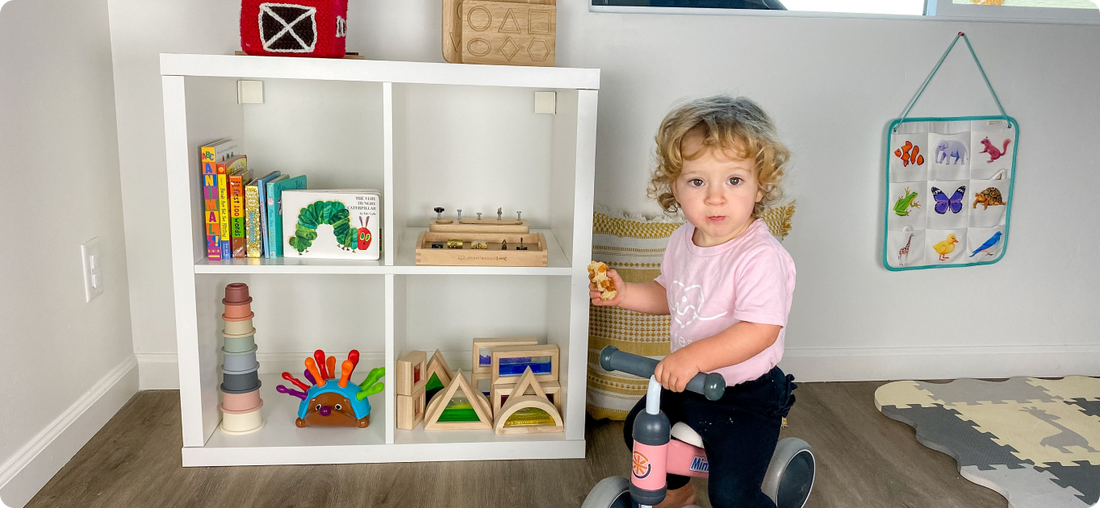You’ve done your research, and you know the Montessori method is what you want for your children. You’re ready to set up your at-home learning space but not sure where to start.
And there is a lot of conflicting information these days about what is and what isn’t Montessori, especially when it comes to materials.
Here are 9 things you should know about at-home Montessori materials.
1. Find items that grab children’s attention.
Dr. Maria Montessori encouraged hands-on learning, and the right materials are everything. The most important thing a material needs to do is grab your child’s attention in a permanent way.
Montessori materials are engaging and promote creativity in children. They invite children to experience and experiment. Montessori materials are beautiful, educational, and welcoming.
Montessori items are top-quality products and, when cared for, can last for years and years. So always, always choose quality over quantity. A few well-chosen and quality items are far better than a roomful of low quality items.
2. Categorize your materials.
Montessori materials fit into three categories: academic, sensorial, and practical life.
Academic materials target language, science, and math. Classic items include sandpaper letters, number rods, and wooden tracing boards.
Sensorial materials are what you think they are. They allow children to learn through their senses. Sensory learning is key to brain development, and sensorial stimuli literally make children’s brains grow, especially from ages 3 to 7. When choosing sensory materials, think wooden cubes, brass bells, and the evergreen pink tower.
Practical life focuses on the tools and tasks of everyday life–washing dishes, folding clothes, and preparing food. Children crave independence, and letting them participate in the activities of daily life gives them confidence. So let them dress themselves and wipe down the table after dinner.
3. Opt for natural products.
Here is where much of the “what is and what isn’t Montessori” discussion lands. And you can make yourself crazy worrying about it.
Instead of perfection, go for consistency and opt for natural products like wood, brass, glass, and woven textiles when you can.
Natural goes for lighting, too. Choose sun-filled spaces and avoid artificial lighting. What’s even better? Go outside. After all, there’s nothing more natural than nature.
4.Choose glass over plastic.
In keeping with the natural materials, go for glass over plastic. There are many products out there that make life easier in the short term: sippy cups, no-spill lids, etc. But these products are not aligned with practical life learning, and they are not Montessori.
Dr. Montessori believed in the independence and capabilities of children. She believed they should pour water into a real glass, peel a real carrot, and use a real knife.
Jars spill, and glasses break. That’s part of life. These items are real and command respect. They teach children about the delicate aspects of our world.
5. Use child-sized furniture and tools.
When selecting Montessori materials, think about them from a child’s perspective. Children are smaller, and you need to keep that in mind when thinking about materials. Dr. Montessori called her school Casa dei Bambini, or Children’s House, for a reason.
Also, children are closer to the ground. Make the floor your new best friend, because that’s where children spend much of their time. Place materials where children can access them and put them away. Trays are great, too; they contain all the items for one activity in a single space, and children can carry them to wherever they choose to work.
And remember that furniture and tools should be child-size, too.
6. Include open-ended and close-ended toys.
Open-ended vs. close-ended toys is another area of Montessori debate. Again, don’t get caught up in this discussion. Spoiler alert - both are fine.
Open-ended toys like art supplies, vehicles, and dolls encourage imagination. And there are no rules. The possibilities are endless. Open-ended toys are great for independent play because children can retell stories, make up stories, and even work through things.
Close-ended toys like puzzles and object matching work have boundaries, and that makes children feel safe. There is order and self-correction, and working with close-ended toys gives children a sense of accomplishment. And here’s another spoiler alert: children can use close-ended toys in an open-ended way.
7. Leave walls bare.
It’s typical to see school classrooms covered floor to ceiling in instructional posters, pictures, and charts. And it’s tempting to do that in your at-home learning areas as well. But wall-to-wall decoration is overwhelming to children and prevents focus.
Montessori walls should be empty to start and then filled with children’s own work, not pre-made materials. Leave the walls above work shelves bare and even bulletin board free. Let children display their way and decorate their space. This creates a personalized learning environment and gives children agency. Very Montessori.
8. Cut down on clutter and get organized.
Like the walls, all work areas should be clutter-free and organized. A prepared Montessori environment might seem sparse, but that’s by intention. Every item has its place, allowing children to get out their work and put it away.
And a good “shelfie” isn’t just for Instagram. A calm, orderly at-home learning space makes children feel safe. Order provides predictability, and a well set-up environment means that children can maintain the space themselves.
Also, cozy spaces are clutch. Children need soft furnishings where they can curl up and work. The juxtaposition of textures is very important in Montessori spaces, so make sure your at-home space has a balance of both hard and soft furnishings.
9. Let Montessori & Me get you started.
Ready to bring Montessori materials into your home? Let Montessori & Me get you started.
See our wide range of products, including tracing boards, pegboards, and object permanence boxes. All products are eco-friendly and made with sustainability in mind.
Start your own Casa dei Bambini today!




